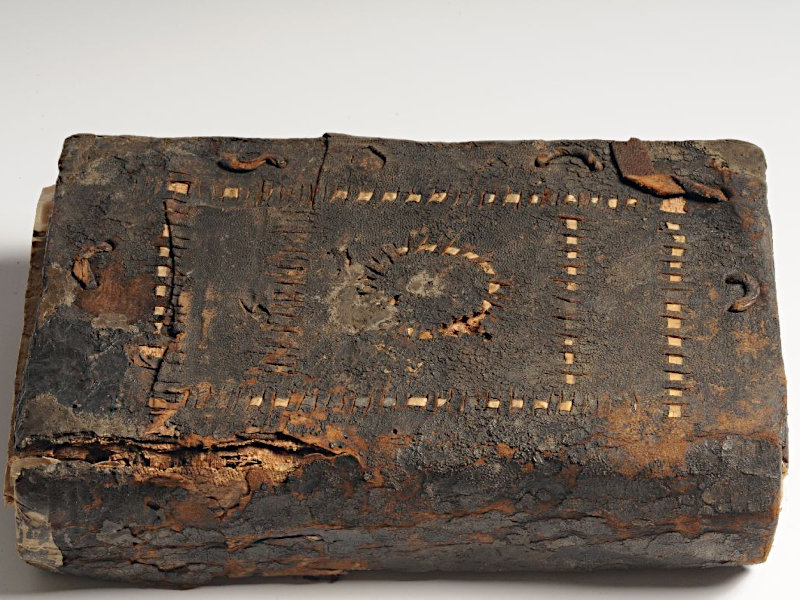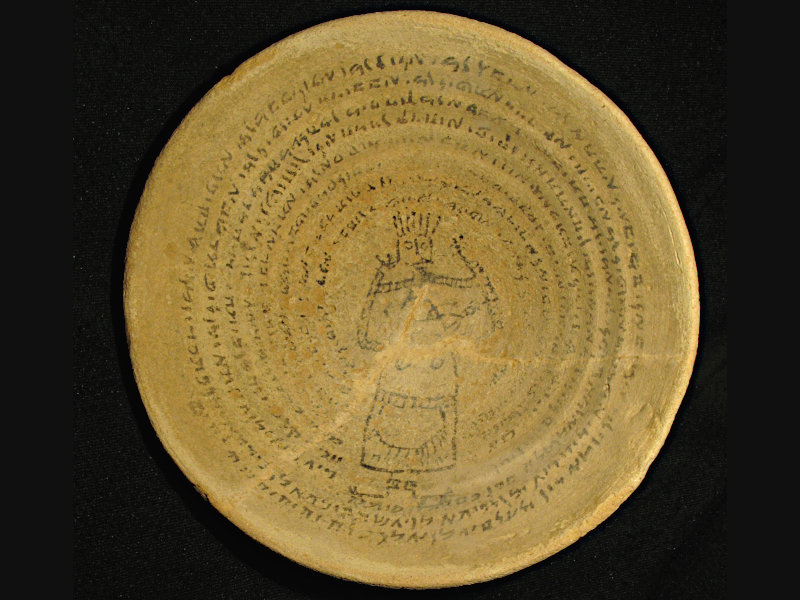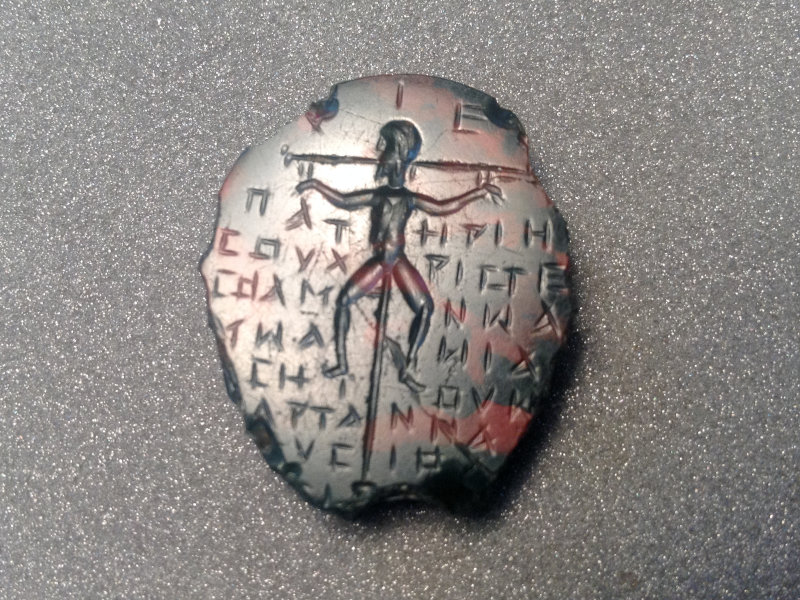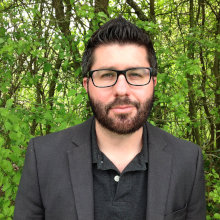EJCM
Early Jewish and Christian Magical Traditions
About
EJCM will contribute to the study of both Mediterranean magic and Jewish-Christian relations during late antiquity (III–VIII CE) by providing the first sustained, comparative analysis of early Jewish and Christian magical texts and objects (e.g., amulets and incantation bowls). This project will focus on the similarities, differences, and contacts between these traditions in five central aspects of their magical practices:
- biblical texts and traditions
- sacred names and titles
- healing and demonic protection at the interface of literary and material sources
- the word-image-material relation
- references to illicit rituals
Accordingly, EJCM will illuminate the dynamics of religious assimilation, cooperation, and differentiation in the everyday lives of ancient Jews and Christians.
Like most individuals living in the ancient Mediterranean, Jews and Christians believed that the world was populated with otherworldly beings (e.g., angels, demons, and ghosts) that could either provide assistance or cause spiritual and physical harm.
In order to deal with this dire and complex situation, Jews and Christians sought the help of ritual experts (e.g., Christian priests, monks, Jewish rabbis, and neighborhood healers), who were entrusted to combat, appease, or invoke such beings.
These so-called “magicians” created various kinds of aids for the healing and protection of their clients, including amulets (often made from papyrus or parchment) to place around the neck and earthenware bowls to bury under the house. Fortunately, many of these artifacts have survived from antiquity and include inscribed citations from sacred texts, drawings, divine names, and references to various ritual practices.
In many cases, however, the objects conflict with our inherited ideas about the boundaries between early Judaism and Christianity. Several amulets, for instance, include both traditional Christian language (e.g., the Trinity) and traditional Jewish language (e.g., Iâo Sabaôth). Unfortunately, such objects are often merely described or castigated as “syncretistic” or as reflecting the polytheistic world of late antiquity. But such identifications – without further nuance and attention to the complex social dynamics of late antiquity – obscure at least two distinct phenomena:
- the intentional usage of foreign or exotic names, practices, etc. for ritual efficacy
- and the use of cultural elements that had already been absorbed into new cultural contexts and had, therefore, lost their original associations.
Indeed, these objects raise various questions about their social contexts:
- Do they reflect cooperation between Jewish and Christian ritual experts?
- Do they reflect the assimilation of originally Jewish terminology into the Christian tradition?
- How do these local ritual objects fit into the global world of late antiquity, in which Christians and Jews differentiated themselves from one another and even had violent exchanges?
- To state the problem in more technical terms: how did the dynamics of religious assimilation, cooperation, and differentiation play out in such magical contexts?
This problem requires a study that traverses the academic fields of early Jewish magic, early Christian magic, and early Jewish-Christian relations. Unfortunately, there has been no focused and sustained project that brings together these fields of study.
EJCM focuses on these extant magical objects – and the social historical questions they engender – as sites for thinking about early Jewish-Christian relations and ancient magic, more generally. The principal material artifacts for this project are the Christian Greek and Coptic amulets (including gems and metal armbands) and the Christian handbooks as well as the Jewish Babylonian Aramaic and Syriac incantation bowls. These objects date from approximately the 3rd through the 8th centuries CE and come mainly from Egypt and Mesopotamia (though the armbands and gems have a broader geographical distribution).
Team members will also make use of related material objects, such as the Greek Magical Papyri, the Jewish Palestinian Aramaic amulets, and the Mandaic incantation bowls, as well as magical literary texts, including the Book of the Mysteries and selected passages from the Babylonian Talmud. All such magical materials will be further illuminated through close readings of late antique patristic, monastic, rabbinic, and legal writings that describe or complain about illicit ritual activity.
Topics and methods
Thematic focus and objetcives
In order to bring together these various sources in a coherent manner, the project will focus on five shared ritual practices among late antique Jewish and Christian practitioners:
- the use of biblical traditions;
- the use of sacred names;
- the linking of words, images, and materials;
- the presentation of illicit ritual
- and the intersection of the literary and material records (in terms of proscribed healing, apotropaic, and exorcistic practices).
Although each team member will emphasize one of these dimensions in his/her research though, we will all grapple with each of these issues to a degree.
Team members will analyze these shared practices, with particular attention to the four primary objectives of the project:
- to synthesize insights from ancient magical studies, comparative history and religion, art history, and sociology in order to illuminate the local and global features of early Jewish and Christian magical objects and to assess their implications for the study of early Jewish-Christian relations;
- to offer unique insight into the dynamics of religious assimilation, cooperation, and differentiation in late antique lived religion;
- to reconfigure the ways historians of antiquity approach key terms in the field, especially Judaism, Christianity, magic, syncretism, and communal boundaries;
- to provide new readings of patristic, rabbinic, and legal texts, which describe or complain about Christians and Jews participating in illicit rituals.
Methodology
The project’s synthetic methodology, which draws from various disciplines, including religious studies, sociology, and art history, further unites the scholarly endeavors of the individual team members. The methodology is oriented around a series of questions and problems, which fall into three basic areas.
1) Text and artifact
First, we will focus on both text and artifact. This methodological area involves several dimensions. For instance, team members will draw on the insights of recent scholarship on how to identify the amuletic or magical function of an object. Indeed, it is not always clear, for instance, if a small biblical artifact was primarily meant to be used as an amulet or was primarily designed for another purpose (e.g., a memory aid). Team members will take into consideration the material and textual properties of the object in order to help identify its primary function (especially in terms of its created purpose).
Are there holes on the object (which might suggest that it was worn as an amulet)? Does the shape and character of the artifact – as well as its texts, symbols, or images – resemble other objects with known magical functions? It should be noted that this project operates from the general assumption that objects could serve multiple functions for their users, even for a single user. Carrying a papyrus with a psalm inscribed on it to church, for instance, might have meant one thing; however, that same object probably served a totally different function when the carrier was sick or afraid of demonic attack.
Although one of the project’s areas focuses specifically on the various ways early Jews and Christians approached the intersection of words, images, and materials in their ritual practices, all team members will attend to the interaction of these features to a degree. For instance, how do the material properties or the format of the object contribute to its overall function and meaning? How do both words and images engage local and global traditions?
2) Social dynamics
The second methodological area deals with social dynamics. For instance, the project will grapple with contemporary theory on the relationship between identity, the individual, and groups in order to answer various questions, the most important of which is: to what extent was religious identity operative in late antique magic? For this question, we will engage critically with the work of scholars, such as sociologist Rogers Brubaker (2002) and Bernard Lahire (2011), who have highlighted the ways individuals can align themselves with different groups depending upon the situation and context.
We will also make use of the work of historians of religion, such as Michael Pye (1994), to address questions of syncretism and cultural interaction. Thus, to what extent did elements, which were originally Jewish (e.g., Iaô Sabaôth and Rab. Joshua bar Peraḥya) or Christian (e.g., the name Jesus or a cross), continue to be understood as specifically Jewish or Christian by subsequent users?
3) Comparison and classification
Finally, the project will engage with theoretical work on comparison and classification. The team’s comparative study of Jewish and Christian magical traditions will draw upon the work of historian Victoria Bonnell (1980) and its application for the study of late antiquity by David Frankfurter (2012). This model makes the distinction between the analytical use of comparison (i.e., comparison oriented around similar kinds of individuals/groups at a particular period of time) and the illustrative use of comparison (i.e., comparison oriented around a broader idea, concept, or model that transcends specific groups or a particular time period).
This two-fold approach will help the team members examine early Jewish and Christian magical practices as equivalent historical units (i.e., the analytical use of comparison) and to reflect on the relationship between this material evidence and broader scholarly categories, such as magic, Judaism, Christianity, religion, scripture, syncretism, and boundaries (i.e., the illustrative use of comparison).
In addition, the project will also make use of scholarship on taxonomy and classification from various fields in order to address the following question: to what extent should we allow ancient sources to frame our scholarly categories?
Conclusions
EJCM applies a new framework that allows for a reassessment of the local and global dynamics that stood behind early Jewish and Christian magical practices. This framework not only makes a unique and important contribution to the study of both ancient magic and early Jewish–Christian relations by bridging these sources (which are typically analyzed in isolation), but it also applies to them a robust, interdisciplinary methodology, which synthesizes insights from various academic fields, including history, religious studies, sociology, and art history.
The joining of these fields and sources will produce significant information about the past by revealing how religious assimilation, cooperation, and differentiation worked in ancient rituals, on the one hand, and by illuminating the ways Jews and Christians configured the symbolic, social, and material boundaries between their respective communities in lived contexts, on the other hand. Beyond supplementing the literary evidence, the Jewish and Christian material objects challenge scholars to redraw many of the constructs they currently use to describe and think about ancient magic and early Jewish-Christian relations (e.g., syncretism and communal boundaries)
These artifacts also recontextualize patristic, rabbinic, and legal texts that describe or complain about believers participating in illicit rituals or interacting with religious and ethnic Others.
This synthetic project will also better equip scholars to evaluate the extent to which we can usefully distinguish between Jewish and Christian magical traditions and Judaism and Christianity more generally in late antiquity. In the end, this interdisciplinary project will offer a unique portrait of the intersecting histories of early Judaism and early Christianity.
Bibliography
This working bibliography is not designed to be comprehensive of the study of ancient magic in general, but is oriented around the most important primary texts and scholarly resources relevant to the study of early Jewish magic and early Christian magic.
Selected primary sources: (revised) editions and corpora
- Bonner, Campbell. 1950. Studies in Magical Amulets. Chiefly Graeco-Egyptian. Ann Arbor, University of Michigan Press.
- Choat, Malcolm and Iain Gardner, eds. 2014. A Handbook of Ritual Power in the Macquarie Collection (P.Macq. I 1). Brepols: Turnhout.
- Daniel, Robert W. and Franco Maltomini, eds. 1990-92. Supplementum Magicum. 2 vols. Opladen: Westdeutscher Verlag.
- Kotansky, Roy. 1994. Greek Magical Amulets: The Inscribed Gold, Silver, Copper, and Bronze Lamellae. Part 1: Published Texts of Known Provenance. Opladen: Westdeutscher Verlag.
- Kropp, Angelicus, ed., 1930-1931. Ausgewählte koptische Zaubertexte. Vol. 3, Einleitung in koptische Zaubertexte. 3 vols. Brussels: Édition de la Fondation égyptologique Reine Élisabeth.
- Levene, Dan, ed., 2013. Jewish Aramaic Curse Texts from Late Antique Mesopotamia: "May These Curses Go Out and Flee". Leiden: Brill.
- Levene, Dan, 2003. A Corpus of Magic Bowls: Incantation Texts in Jewish Aramaic from Late Antiquity. London: Kegan Paul.
- Luijendijk, AnneMarie, 2014. Forbidden Oracles? The Gospel of the Lots of Mary. Tübingen: Mohr Siebeck.
- Mastrocinque, A. 2014. Les intailles magiques du départment des Monnaies, Médailles et Antiques. Paris: BnF.
- Meyer, Marvin W. and Paul A. Mirecki. eds. 2001. Ancient Magic and Ritual Power. Leiden: Brill.
- Michel, Simone (with Peter Zazoff and Hilde Zazoff), eds. 2001. Die Magischen Gemmen im Britischen Museum, 2 Vols. London: British Museum Press.
- Michel, Simone, 2004. Die Magischen Gemmen. Zu Bildern und Zauberformeln auf geschnittenen Steinen der Antike und Neuzeit. Berlin: Akademie Verlag.
- Moriggi, Marco ed. 2014. A Corpus of Syriac Incantation Bowls: Syriac Magical Texts from Late-Antique Mesopotamia. Leiden: Brill.
- Naveh, Joseph and Shaul Shaked, eds. 1995. Amulets and Magic Bowls: Aramaic Incantations of Late Antiquity. 3rd ed. Jerusalem: The Magnes Press, Hebrew University.
- Naveh, Joseph and Shaul Shaked, 1993. Magic Spells and Formula: Aramaic Incantations of Late Antiquity. Jerusalem: Magnes Press, Hebrew University.
- Preisendanz, Karl. ed. 1973. Papyri Graecae magicae: Die griechischen Zauberpapyri, 2 vols. Rev. ed. A. Henrichs. Stuttgart: Teubner.
- Segal, J. B. (with a contribution by E. C. D. Hunter). 2000. Catalogue of the Aramaic and Mandaic Incantation Bowls in the British Museum. London: British Museum Press.
- Shaked, Shaul, James Nathan Ford, and Siam Bhayro, eds. 2013. Aramaic Bowl Spells: Jewish Babylonian Aramaic Bowls, Vol. 1. Leiden: Brill.
- Stegemann, Viktor, ed. 1934. Die koptischen Zaubertexte der Sammlung Papyrus Erzherzog Rainer in Wien. Heidelberg: Carl Winters Universitätsbuchhandlung.
- Zwierlein-Diehl, E. 2007. Antike Gemmen und ihr Nachleben. Berlin and New York: De Gruyter.
Selected secondary literature
- Bélanger-Sarrazin, Roxanne. 2017. Catalogue des textes magiques coptes. AfP 63: 367-408.
- Bohak, Gideon. 2008. Ancient Jewish Magic: A History. Cambridge: Cambridge University Press.
- Bohak, Gideon, Yuval Harari, and Shaul Shaked. eds. 2011. Continuity and Innovation in the Magical Tradition. Leiden: Brill.
- Boschung, Dietrich and Jan N. Bremmer, eds. 2015. The Materiality of Magic. Munich: Wilhelm Fink.
- De Bruyn, Theodore. 2017. Making Amulets Christian: Artefacts, Scribes, and Contexts. Oxford: Oxford University Press.
- De Bruyn, Theodore S. and Jitse H. F. Dijkstra. 2011. Greek Amulets and Formularies from Egypt Containing Christian Elements: A Checklist of Papyri, Parchments, Ostraka, and Tablets. BASP 48: 163-216.
- Fauth, Wolfgang. 2014. Jao-Jahwe und seine Engel: Jahwe-Appellationen und zugehörige Engelnamen in griechischen und koptischen Zaubertexten. Tübingen: Mohr Siebeck, 2014.
- Frankfurter, David, ed. 2019. Guide to the Study of Ancient Magic. Leiden: Brill.
- Frankfurter, David, 2018. Christianizing Egypt: Syncretism and Local Worlds in Late Antiquity. Princeton, NJ: Princeton University Press.
- Harari, Yuval. 2017. Jewish Magic Before the Rise of Kabbalah. Detroit, MI: Wayne State University Press.
- Jones, Brice. 2016. New Testament Texts on Greek Amulets from Late Antiquity. London: T&T Clark.
- Korsvoll, Nils Hallvard. 2017. Reconsidering ‘Christian’: Context and Categorisation in the Study of Syriac Amulets and Incantation Bowls. Unpublished dissertation; MF Norwegian School of Theology.
- Meyer, Marvin W. and Richard Smith. eds. 1999. Ancient Christian Magic: Coptic Texts of Ritual Power. Princeton: Princeton University Press.
- Mirecki, Paul and Marvin Meyer. eds. 2002. Magic and Ritual in the Ancient World. Leiden: Brill.
- Saar, Ortal-Paz. 2017. Jewish Love Magic: From Late Antiquity to the Middle Ages. Leiden: Brill.
- Sanzo, Joseph. 2014. Scriptural Incipits on Amulets from Late Antique Egypt: Text, Typology, and Theory. Tübingen: Mohr Siebeck.
- Spier, J. 2007. Late Antique and Early Christian Gems. Wiesbaden: Reichert.
- Stander, Hendrik F. 1993. Amulets and the Church Fathers. Ekklesiastikos pharos 75: 55-66.
- Stratton, Kimberly B. Naming the Witch: Gender, Theory, & Religion. New York: Columbia University Press.
- Stratton, Kimberly B. and Dayna S. Kalleres. eds. 2014. Daughters of Hecate: Women and Magic in the Ancient World. Oxford: Oxford University Press.
- Trzcionka, Silke. 2007. Magic and the Supernatural in Fourth-Century Syria. London; New York: Routledge.
A note on the collection of primary sources
The objectives of this project require that team members draw from a wide-range of primary source material. The initial corpus of published artifacts consists of:
Principal corpus
- Approximately 200 Greek objects (including gems): the Greek objects have been collected in several volumes (e.g., Preisendanz 1974; Daniel and Maltomini 1990, 1992; Kotansky 1994; Meyer and Smith 1999 [English trans.]). Most of the published Greek artifacts that have not been included in larger corpora have been referenced in catalogues of amulets and in similar studies (e.g. de Bruyn 2010; de Bruyn and Dijkstra 2011; Sanzo 2014). The Christian magical gems that include Greek text have been usefully collected in several volumes (e.g., Bonner 1950; Michel 2001, 2004; Spier 2007 [rev. ed. 2013]; Zwierlein-Diehl 2007). The project will also rely considerably on the Campbell Bonner Magical Gems Database for identifying relevant gems and for descriptions.
- Approximately 275 Coptic objects: the relevant Coptic materials have also been edited and included in collected volumes (Kropp 1930, 1931; Stegemann 1934; Meyer and Smith 1999 [English trans.]; cf. Choat and Gardner 2014). Moreover, an exhaustive list of the Coptic materials has been recently published (Bélanger-Sarrazin 2017).
- Approximately 500 JBA magical objects: there are several published collections of the JBA bowls and amulets (e.g., Naveh and Shaked 1985, 1993; Segal 2000; Levene 2003; Shaked, Ford, and Bhayro 2013; Ford and Morgenstern 2019). The project will also benefit from online collections of incantation bowls, including the Virtual Magic Bowl Archive of the University of Exeter.
- Approximately 50 Syriac objects: there is a published corpus of the Syriac magical objects (Moriggi 2014).
Secondary corpus
- Approximately 100 Jewish Palestinian Aramaic amulets: this project will make use of collections and individual editions of these amulets (e.g., Naveh and Shaked 1985; Kotansky 1991, 1994; Kotansky, Naveh and Shaked 1992; McCollough and Glazier-McDonald 1996; Shaked 2006; Naveh 2001, 2002; Peuch 2008; Eshel and Leiman 2010; Yardeni and Bohak 2016; Elitzur Leiman and Leibner 2016). In addition to the approximately 50 Jewish Palestinian Aramaic amulets that have been published, this project will also make use of the recent dissertation work of Rivka Eilitzur-Leiman, who has identified and analyzed approximately 50 unpublished exemplars.
- Approximately 125 Mandaic incantation bowls: this project will make use of collections and individual editions of these bowls (e.g., Yamauchi 1967; Segal 2000; Müller-Kessler 1999; Müller-Kessler 2010; Morgenstern 2011; Morgenstern and Schlüter 2016; Ford and Abudraham 2018).
- References to Magic in Jewish and Christian literary sources: this project will make use of collections of Jewish and Christian literature and imperial legal texts on magic (e.g., Bohak 2008; Harari 2017; Stander 1993; Trzcionka 2007; de Bruyn 2017; Rives 2003; Sandwell 2005; Sanzo 2019).
Because new objects are continually being discovered, edited, and published, each team member will be assigned a series of academic outlets to examine for recently edited materials and relevant publications. Such outlets will include: ongoing catalogues of artifacts, such as the Oxyrhynchus Papyri project of the Egyptian Exploration Society and volumes in the series Magical and Religious Literature of Late Antiquity (Leiden: Brill), and academic journals, such as the "Bulletin for the American Academy of Papyrologists", "Zeitschrift für Papyrologie und Epigraphik", "Archiv für Papyrusforschung", the "Journal of Jewish Studies", "Jewish Studies Quarterly", and the "Journal of Near Eastern Studies".
Team
Joseph Emanuel Sanzo
Principal Investigator
Associate Professor of History of Religions




